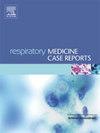复发性血胸诊断肺动脉动静脉畸形1例
IF 0.8
Q4 RESPIRATORY SYSTEM
引用次数: 0
摘要
背景:肺动静脉畸形(PAVM)是肺动脉和肺静脉之间的异常连接,由右至左分流引起各种并发症。然而,由PAVM引起的出血性并发症是罕见的。病例报告我们报告了一个61岁的妇女与PAVM合并血胸的情况。她在孕前35年有右胸血病史,原因不明。虽然两个月前在胸部计算机断层扫描上发现了PAVM,但对患者进行了观察。患者因背痛和呼吸困难到附近医院就诊,无任何诱因,无外伤史。胸部增强CT显示右上肺叶后段和左上肺叶尖后段各有一处PAVM。详细的检查显示,过去和现在的血胸都是由于靠近右上肺叶胸膜的PAVM破裂所致。由于在第一次住院期间,假定的血胸没有进展,因此对患者进行了保守治疗。血胸消退后,患者在本院接受了选择性线圈栓塞术。随访10个月无血胸复发。结论PAVM可引起血胸复发,在评价血胸时应予以考虑。如果不能确定血胸的原因,在很长一段时间后,PAVM可能会变得明显。本文章由计算机程序翻译,如有差异,请以英文原文为准。
Pulmonary arteriovenous malformation diagnosed by recurrent hemothorax – A case report
Background
A pulmonary arteriovenous malformation (PAVM) is an abnormal connection between a pulmonary artery and vein that causes various complications owing to a right-to-left shunt. However, hemorrhagic complications developing from a PAVM are rare.
Case report
We report the case of a 61-year-old woman with a PAVM complicated by hemothorax. She had a history of right hemothorax with no identifiable cause during pregnancy 35 years prior to presentation. Although the PAVM had been identified on chest computed tomography two months previously, the patient was observed. She visited a nearby hospital with back pain and dyspnea without any inciting factor nor history of trauma. Contrast-enhanced chest CT showed a PAVM in the posterior segment of the right upper lobe and another in the apical-posterior segment of the left upper lobe. Detailed examinations suggested both past and present hemothorax due to rupture of the PAVM close to the pleura of the right upper lobe. As there was no progression of the presumed hemothorax during the index hospitalization, the patient was managed conservatively. After the hemothorax resolved, the patient underwent elective coil embolization at our facility. No recurrence of hemothorax was observed over a 10-month follow-up period.
Conclusion
A PAVM can cause recurrent hemothorax, and should be considered when evaluating a patient with hemothorax. If the cause of the hemothorax cannot be identified, a PAVM may become apparent after a long period of time.
求助全文
通过发布文献求助,成功后即可免费获取论文全文。
去求助
来源期刊

Respiratory Medicine Case Reports
RESPIRATORY SYSTEM-
CiteScore
2.10
自引率
0.00%
发文量
213
审稿时长
87 days
 求助内容:
求助内容: 应助结果提醒方式:
应助结果提醒方式:


